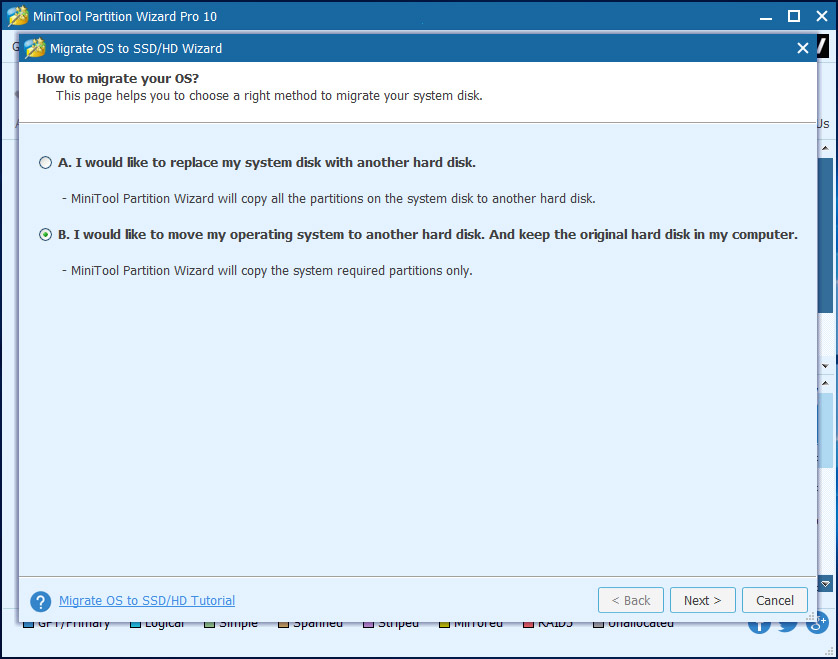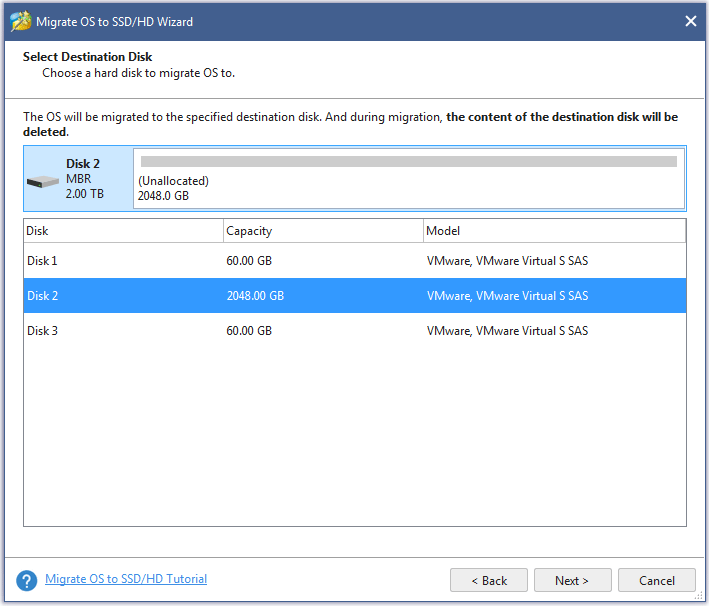Minitool Partition Wizard Migrate Os To Ssd
- Transfer Os To Ssd Free
- Minitool Partition Wizard Migrate Os To Ssd Hard Drive
- Minitool Partition Wizard Cannot Migrate Os To Ssd
In this interface please choose the module “Migrate OS to SSD/HD Wizard”. Note: this function just migrates the Windows which is running. Then, select the target disk to save the copy of Windows and click “Next”. Next, change the size and location for Windows system partition on the target disk and click “Next”. 2) เปิดโปรแกรม MiniTool Partition Wizard แล้วคลิก Migrate OS to SSD/HD ที่แถบด้านบน. 3) เลือกรูปแบบการย้ายข้อมูลจาก HDD ไป SSD (แนะนำแบบ B ตามตัวอย่าง).
- Migrate OS is an easy-to-navigate wizard to copy your OS to a new HDD or SSD. Boot and System partitions will be automatically selected in this feature to ensure the target disk can be correctly booted after the work. To migrate OS: 1. Click Migrate OS from the Tool bar. Select a target disk. Edit the partition size on the.
- 'Migrate OS to SSD/HDD' feature of EaseUS Partition Master can help you transfer all data on system and boot partitions includes OS and applications to new SSD or HDD without reinstalling Windows OS and apps. This feature will significantly save your time. Please follow the step-by-step tutorial below to migrate OS from HDD to SSD.
- Hard drive cloning. Minitool partition wizard.
Summary :
This article will tell you what 3.5 SSD refers to, why there are few such drives while giving some examples of them, and how to easily migrate a computer system to it and ensure the system bootable at the same time. Learn more information on MiniTool.
Quick Navigation :
What Does 3.5 SSD Mean?
3.5 SSD refers to solid-state drive (SSD) of 3.5-inch (3.5') size. Actually, according to industry standards, a 3.5-inch SSD is 4 inches (101.60 mm) in width, 5.75 inches (146,05 mm) in depth, and 1 – 1.63 inches (25.40 – 41.40 mm) in height.
The 3.5' SSD typically makes use of the serial ATA (SATA) or serial-attached SCSI (SAS) to transfer data to and from the computer system. It fits into the save drive bay as a hard disk drive (HDD), that is identical in form factor, on the computer motherboard.
SSDs and HDDs are mainly in two kinds of form factors, most in 2.5 inches (small form factor, SFF) and some in 3.5 inches (large form factor, LFF). And, the 3.5-inch and 2.5-inch measurements represent the approximate diameter of the drive platter within the drive enclosure. That is why a 3.5-inch solid state drive is of four inches in width and 5.75 inches of depth. The width and depth are the sizes of the disk enclosure.
Transfer Os To Ssd Free
Related article: Do SSD Drives Fail: A Complete Analysis on SSD Technology
Why Are There Few 3.5 SSDs?
When you plan to buy a 3.5 inch SSD and search it online, you can see many retailers listed in the search result including Amazon, Newegg, eBay, Ebuyer, etc. yet, when you click into the page, you may find among the listed items, few are actually SSD or even no one matches your search. Instead, most of the results are HDDs or 2.5' SSDs. Since the search function of those online retailers hardly fails, it must be the reason that there are actually a few SSD of 3.5' size. Then, why is it so?
Why are there so few 3.5-inch SSD? Is it just because the demand for this kind of drive is little? Or, is it that 2.5-inch SSDs are mostly needed on laptops? The probably reasons are as the following ones:
1. Demand of Consumers
In general, laptops sale more than desktops. Since laptops are compatible with the 2.5-inch size of hard drives, to meet most customers’ needs, hard disk manufacturers will produce more 2.5 SSDs than 3.5 SSDs.
2. Compatibility
Compared to 2.5' SSD, 3.5' ones are less compatible. Even if your hard drive bay is for a 3.5-inch disk and you have a 2.5-inch drive, you can mount your current 2.5-inch drive with mounting kit adapters and the adapters are relatively inexpensive compared to buy a new 3.5-inch SSD.
What’s more? A lot of new desktop and server cases are designed to have at least one native 2.5-inch drive mount. To install an SSD, if it is 2.5 inches, in some situations, it is just a matter of installation; in other situations, it is simply a matter of density and you are able to fit more 2.5' SSDs in the same space as 3.5' SSD. This happens more in server cases than desktop cases.
3. Matter of Physical Space
Since there is little demand for 3.5-inch SSDs, will they disappear in the hard drive market? No, it will not. One of the reasons is that they allow for larger platters with a larger disk enclosure. Thus, a 3.5' hard drive generally has a larger disk capacity. Yet, a large enough SSD requiring a 3.5-inch design will be extremely expensive, which won’t be accepted by most users.
4. Manufacturing Problem
It costs less to build one enclosure design than two. To save cost, manufacturers would like to produce the most popular hard drive enclosure of 2.5' size instead of the 3.5' one. So, there are few companies that produce 3.5-inch SSDs.
What are the differences between 2.5 HDD and 3.5 HDD? This post shows some differences between these two hard drive form factors.
Is It Possible to Buy 3.5 SSD?

Minitool Partition Wizard Migrate Os To Ssd Hard Drive

Since there are few SSDs of 3.5 inches, am I able to purchase one somewhere? Many computer users may ask such questions. Let’s discuss this topic in detail.
For laptops, you can find many 3.5-inch SSDs in the market. Yet, for desktops, there are few but they do exist. By searching “3.5 inch internal solid state drive” on Amazon, you can find several items that match your requirements. And, it seems that most of the matches are from the brand OCZ.
Even there are 3.5' SSDs for you to buy, they are very expensive compared to consumer SSDs. The large form factor SSDs are for large business enterprise configurations.
Some 3.5 SSDs on the Market
Though the 3.5-inch SSDs are few, they do exist and below are some of them.
#1 HP 653122-B21 3.5-inch Solid State Drive
This HP 3.5-inch SSD adopts a 3.0 Gb/s SATA data transfer interface, MLC (multi-level cell) NAND flash memory, and wire device connectivity. Its capacity is 100 GB and its current price is 301 pounds on Amazon. The product dimensions are 15.24 x 27.97 x 22.86 cm, that’s 6 x 11 x 9 inch, and weighs 480.81 grams.
#2 OCZ Vertex 2 3.5-inch Solid State Drive (OCZSSD3-2VTX360G)
This black 3.5 SSD hard drive is equipped with SATA II 3.0 Gb/s interface with a maximum read speed of 285 MB/s, max write speed up to 275 MB/s, sustained write speed up to 250 MB/s. Its dimensions are 5.8 x 4 x 1 inch, and capacity is 360 GB.
#3 Lenovo 5300 480 Gb Solid State Drive
The 5300 Entry SATA SSD is a new SSD for Lenovo ThinkSystem servers. It makes use of Micro 96-layer 3D NAND flash memory technology, a SATA 6 GB/s interface, and provides an affordable solution for read-intensive applications. The drive offers 480 GB data storage, a high-read speed of 540 MB/s, and a high-write speed of 410 MB/s.
#4 HPE P07924-B21 3.5' SATA Internal Solid State Drive
This 3.5-inch SSD produced by HPE offers high performance, exceptional reliability, and efficiency for faster business results. It is ideal for big data analytics; achieves higher IOPs to enhance data center performance; maintains data accuracy by full SSD brands such as Lenovo, OCZ, Imation, etc.

Compare 3.5- and 2.5-inch SSD, as for the difference between 2.5 and 3.5 SSD, the biggest difference is their sizes. And, 3.5' SSDs are mainly used on Desktop while 2.5' ones are for laptops. Also, the two sizes of drives are different in storage capacity, power consumption, cache size, RPM (Revolutions Per Minute), data transfer speed, etc. For more differences between these two sizes of disks, you can refer to 2.5 VS 3.5 HDD: What Are the Differences and Which One Is Better?
In general, it is hard to say which one is better. It all depends on different using situations.
Minitool Partition Wizard Cannot Migrate Os To Ssd
Today, I came across a headline that asked, “How to migrate Windows 7 OS from HDD to SSD on a multi partition disk with system & boot volume separate?”
Then, I searched lots of materials, and found an effective solution as follows.

How to Migrate OS with System & Boot Volume Separate
Here, I have a laptop running Win7 equipped with:
Disk 1: WDC HDD 465 Gb with 2 partitions:
C – New volume – which hosts my current (active) Windows 7 Home OS partition
F – Data – which contains a number of data files
Disk 2: Samsung 830 Series with:
System Reserved – volume currently active & boot
D – (no label) which contains a corrupt old version of Windows 7 Home OS
In this situation, I successfully transferred Windows 7 operating system to a new hard drive.
Want to know the details?
First, I turn to the Move/Resize Partition provided by MiniTool Partition Wizard to release some free space from disk 2, and then create a new partition (format it as FAT32, but without a volume letter) on it by, and move the new partition to the front of the disk 2.
Then, turn to a professional Backup tool to back up the system reserved partition (100MB) on the disk 1 to the newly created partition on disk 2.
Finally, connect a new hard drive to computer again and then turn to MiniTool Partition Wizard again, for it offers Migrate OS to SSD/HD Wizard feature to help to easily and quickly transfer the operating system from normal hard disk to SSD/HD.
The Migrate OS to SSD/HD post will show you more information about migrating OS.
Bottom Line:
Are you still worried about migrating OS? Now, with MiniTool Partition Wizard, you can quickly transfer OS from normal hard disk to another new one, for this very easy-to-use tool offers excellent performance.